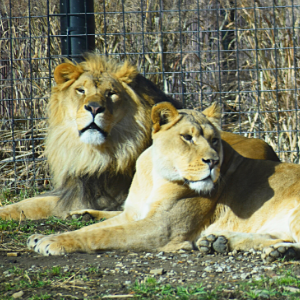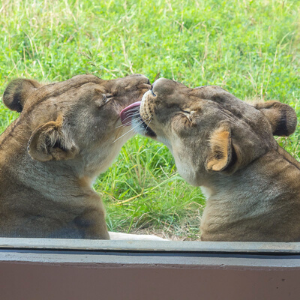 Many years ago, lions could be found throughout Africa, Eurasia, North America, and the northern part of South America. Sadly, due to habitat loss, loss of prey and humans defending themselves and their livestock, many lion species are now endangered or extinct. Today, only two species of lion remain – the Asian lion, found in the protected Gir Forest in India, and the African lion, which can be found in sub-Saharan Africa (and at your Akron Zoo). This World Lion Day, we would like to teach you more about these unique big cats and introduce you to the individuals that make up our two Akron Zoo prides!
Many years ago, lions could be found throughout Africa, Eurasia, North America, and the northern part of South America. Sadly, due to habitat loss, loss of prey and humans defending themselves and their livestock, many lion species are now endangered or extinct. Today, only two species of lion remain – the Asian lion, found in the protected Gir Forest in India, and the African lion, which can be found in sub-Saharan Africa (and at your Akron Zoo). This World Lion Day, we would like to teach you more about these unique big cats and introduce you to the individuals that make up our two Akron Zoo prides!
Lions are some of the largest big cats in the world, second only to some species of tigers. They are the only big cats who are sexually dimorphic, meaning the males and females have distinct physical differences. Male lions have a mane of long hair, making them appear larger and more threatening when defending their territory. Females, on the other hand, are smaller and have no mane, helping them to camouflage during hunting. As the largest predator in their range, they most often hunt zebra, wildebeest, Thompson’s gazelles and impalas, and they play an important role in keeping the populations of these species under control.
Lions are the only social big cat species. Both in their native habitats and in zoos, lions live in family groups known as prides. A pride usually contains one male, several related females and their cubs. Your Akron Zoo is home to two prides of lions. Our smaller pride consists of one male, named Tamarr, and one female, named Mandisa. Tamarr was born in 2005, making him the oldest of the Akron Zoo’s lions. In his native habitat this would be considered remarkably old, but in zoos lions have been known to live to the ripe old age of 20 or more! As the male, Tamarr is the “king” of his pride, though Mandisa has clearly been in charge since the two were introduced in 2013.
Donovan, the zoo’s second male lion, is the head of the larger pride and lives with females Msinga and Kataba. The group was introduced in 2019 when they made their debut in Landon and Cynthia Knight Pride of Africa. Donovan is the largest lion at the Akron Zoo, weighing just over 450 pounds. When he arrived, he was easy to identify because his mane was thinner and lighter than Tamarr’s. However, as male lions get older, their manes often become darker, as was the case with Donovan. Despite his size and grandeur, the females are still clearly running the show in this pride. Kataba is adventurous and confident, while Msinga prefers for her sister to make decisions. The two prefer to spend time with each other, though they occasionally let Donovan lay down nearby.
 Many of our guests note that they have never seen all five of our lions at once. This is because our two prides do not share space with one another. Lions are territorial animals, and unrelated males and unrelated females would fight for dominance if they were given access to the same space. Instead, the Akron Zoo has both a public yard and a private yard for our lions, and we rotate which pride has access to which space throughout the week. Tamarr and Mandisa are in the public habitat Mondays – Wednesdays, and Donovan and his ladies are out Fridays – Sundays. The two pairs alternate Thursdays. Though they have never met, the two prides are aware of each other, and can sometimes be heard roaring at each other. These roars can be heard for up to five miles, and are meant to warn the other group to stay away.
Many of our guests note that they have never seen all five of our lions at once. This is because our two prides do not share space with one another. Lions are territorial animals, and unrelated males and unrelated females would fight for dominance if they were given access to the same space. Instead, the Akron Zoo has both a public yard and a private yard for our lions, and we rotate which pride has access to which space throughout the week. Tamarr and Mandisa are in the public habitat Mondays – Wednesdays, and Donovan and his ladies are out Fridays – Sundays. The two pairs alternate Thursdays. Though they have never met, the two prides are aware of each other, and can sometimes be heard roaring at each other. These roars can be heard for up to five miles, and are meant to warn the other group to stay away.
Lions are considered a vulnerable species, with populations dropping as much as 43% since the mid-90’s. Today the greatest threat to lions are farmers and builders who want to protect their land and livestock. To help protect lions in their natural habitat, the Akron Zoo has partnered with Rebuilding the Pride to support people in the Southern Rift Valley of Africa. With the use of bomas, a thorny enclosure that protects livestock at night, farmers are able to live sustainably and peacefully coexist with wildlife like lions. The hope is that this effort will reduce conflict between humans and lions, allowing lion populations to recover in their natural habitat.
So happy World Lion Day! Be sure to visit these beautiful big cats, along with the more than 1000 animals who call the Akron Zoo “home.” We hope to see you soon!
